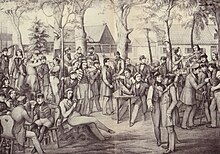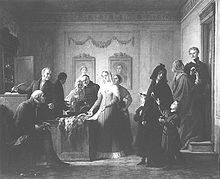Gustav Graef
Gustav Graef (born December 14, 1821 in Königsberg , † January 6, 1895 in Berlin ) was a German history and portrait painter .
life and work
In Königsberg (Prussia) Gustav Graef was an enthusiastic member of the Corpsland Team Normannia since 1842 . Many lithographs by (incorporated) Königsberg students come from that time. He was trained as a history and portrait painter in Düsseldorf by Theodor Hildebrandt and Wilhelm von Schadow at the Royal Academy . He made study trips to Antwerp, Paris, Munich and Italy. After returning to Königsberg, he married the painter and lithographer Franziska Liebreich (1824-1893), who came from an important Jewish family and whom he had met as a student in his drawing class in Königsberg. The marriage resulted in two sons and a daughter. The son Botho Graef (1857-1917) became a well-known art historian , the daughter married the painter Reinhold Lepsius and, as Sabine Lepsius (1864-1942), became a well-known painter who maintained close contact with the George Circle .
In 1849 Graef was commissioned to create the frescoes The Reconciliation of Wittekind with Charlemagne based on a design by Wilhelm von Kaulbach in the south dome hall of the New Museum in Berlin . The move of the family from Königsberg to Berlin was also connected with this. Another major order followed was the execution of the Four Hercules Acts for the vestibule of the Altes Museum in Berlin. His best known at that time painting Ferdinande Schmettau sacrifices her golden hair on the altar of the motherland in 1813 , which in the wars against Napoleon refers, gave Kaiser Wilhelm I . later the National Gallery . Graef also took up the theme in other of his paintings, including in Vaterlandsliebe in 1813 (98 × 125 cm), which the State Museums, Alte Nationalgalerie in Berlin own. From 1862 Graef turned primarily to idealized female portraits, with which he had great commercial success. In 1868 he received a commission for the three great historical compositions Solon , Phidias and Demosthenes for the auditorium of the University of Königsberg . In 1880 he became a member of the Prussian Academy of Arts , Berlin, Section for the Fine Arts. In the midst of this successful artistic work, Graef was arrested in March 1885 and indicted in a process that was much noticed in Berlin society, but acquitted of the charge of perjury and the abuse of an underage model. The social rank of the family, which was previously the hospitable house of a painter prince suffered great damage from the trial. One of his students, whom he taught in his studio in the Palais Raczyński , was Mathilde Block .
Works in museums (selection)
- National Gallery, Berlin: Ferdinande von Schmettau sacrifices her golden hair on the altar of the fatherland 1813 , oil on canvas 125 × 98 cm
- Ostdeutsche Galerie , Regensburg: The departure of the East Prussian Landwehr into the field in 1813 after their consecration in the church , 1860/61, oil on canvas, 101 × 131.5 cm
- National Portrait Gallery, London: Sir Francis Galton, 1882, oil on panel, 70 × 54 cm
literature
- Count, Gustav . In: Hermann Alexander Müller : Biographical Artist Lexicon. The most famous contemporaries in the field of fine arts of all countries with details of their works . Bibliographisches Institut, Leipzig 1882, p. 215 f. Digitized
- Paul Lindau : The Graef Trial. Three sensational trials in Berlin and two other sensational criminal cases from the end of the 19th century . Edited by Hans Joachim Kruse. Verlag Das Neue Berlin, Berlin 1985.
- Annette Dorgerloh : The artist couple Lepsius. On Berlin portrait painting around 1900. Akademie Verlag, Berlin 2003, ISBN 3-05-003722-9 .
- Dagmar Reese : Act and decency. The scandal surrounding the Gustav Graef trial , Berlin 1885, Böhlau, Cologne 2014, ISBN 978-3-412-22250-5 .
- Barnet Hartston: The Trial of Gustav Graef: Art, Sex, and Scandal in Late Nineteenth-Century Germany , DeKalb: Northern Illinois University Press 2017, ISBN 978-0875807676 .
Web links
Individual evidence
- ↑ Kösener corps lists 1910, 142 , 74
- ^ Hermann A. Müller: Biographisches Künstler-Lexikon, Bibliographisches Institut, Leipzig, 1882
- ↑ Petra Wilhelmy-Dollinger: The Berlin salons: With historical-literary walks, Walter de Gruyter, 2000 ISBN 9783110164145
- ^ Sabine Lepsius, Stefan George, History of a Friendship , Die Runde Verlag, Berlin, 1935
- ↑ Annette Dorgerloh : The artist couple Lepsius. On Berlin portrait painting around 1900. Akademie Verlag, Berlin 2003, ISBN 3-05-003722-9
- ↑ Dagmar Reese, Nude and Decency. The scandal surrounding the Gustav Graef trial, Berlin 1885, Böhlau, Cologne 2014
- ^ Paul Lindau: Interesting cases. Criminal trials from the most recent times. Breslau, Schottlaender, 1888; newly published as "The Graef Process" by the publishing house Das Neue Berlin, 1985 ( https://www.projekt-gutenberg.org/lindaup/prograef/chap001.html )
- ↑ Mention in the general artist lexicon
- ^ National Portrait Gallery Sir Francis Galton by Gustav Graef
| personal data | |
|---|---|
| SURNAME | Graef, Gustav |
| ALTERNATIVE NAMES | Count, Gustav |
| BRIEF DESCRIPTION | German history and portrait painter |
| DATE OF BIRTH | December 14, 1821 |
| PLACE OF BIRTH | Koenigsberg |
| DATE OF DEATH | January 6, 1895 |
| Place of death | Berlin |




